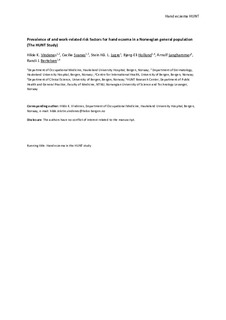Prevalence of, and work-related risk factors for, hand eczema in a Norwegian general population (The HUNT Study)
Vindenes, Hilde Kristin; Svanes, Cecilie; Lygre, Stein Håkon Låstad; Hollund, Bjørg Eli; Langhammer, Arnulf; Bertelsen, Randi Jacobsen
Journal article, Peer reviewed
Accepted version
Permanent lenke
http://hdl.handle.net/11250/2581824Utgivelsesdato
2017Metadata
Vis full innførselSamlinger
Sammendrag
Background
Chemical exposures at work and at home may cause hand eczema. However, this has been scarcely described for Norway.
Objectives
To investigate the prevalence of, and occupational risk factors for, hand eczema in Norway.
Methods
Among 50 805 respondents (aged ≥20 years) to the third Nord‐Trøndelag Health Study (HUNT3), 5757 persons reported ever having hand eczema, and 4206 answered a hand eczema questionnaire.
Results
The lifetime prevalences of hand eczema were 8.4% in men and 13.8% in women (p < 0.001), with onset at age ≤10 years in 24% (men) and 20% (women), and onset at age ≥30 years in 37% (men) and 25% (women) (p < 0.001). Work‐related hand eczema affected 4.8% of the population, and was most frequently associated with health/social work (29%) and occupational cleaning (20%) in women, and with farming (26%) and industrial occupations (27%) in men. Cleaning detergents (75%) and other chemicals (36%) were the most common exacerbating factors.
Conclusions
The prevalence of hand eczema was 11.3%, and that of work‐related hand eczema was 4.8%. Hand eczema was more common in women than in men, but with a later onset in men. Cleaning detergents were the most common aggravating factors. A large proportion of the Nord‐Trøndelag population is employed in farming, providing the possibility to identify farming as an important risk factor for hand eczema.
